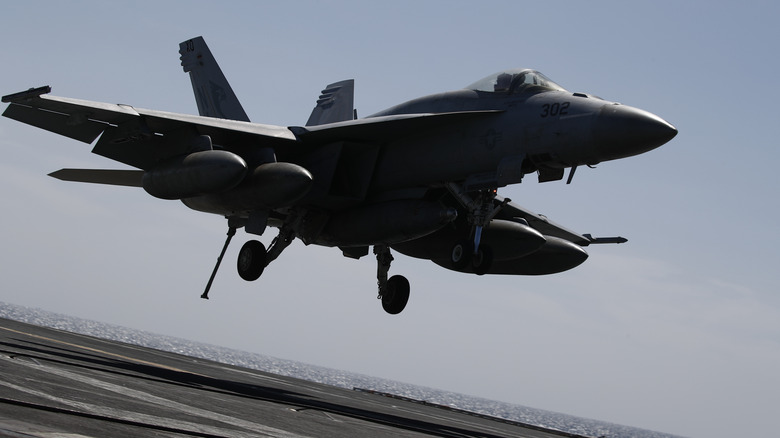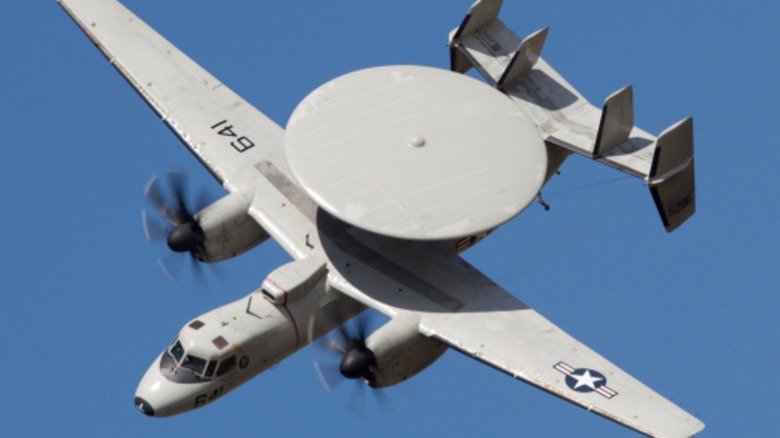Why Does The US Navy Have Planes? Here's What They're Used For
When you look at America's various military branches, the divisions seem cut and dry. The Army has access to tanks and ground forces, the Navy has domain over the ocean, the Marine Corps is an expeditionary force trained in a variety of missions, and the Air Force rules the skies. It's not as simple, though. There's a lot of overlap between the branches because it's necessary. The Army has ships for logistics, while the Air Force isn't the only branch with access to planes. Every branch has aircraft, but the Navy is actually the second-largest air force in the world with an inventory of roughly 3,700 aircraft.
Naval aviators fulfill a variety of roles for the Navy. Of course, there are fighter jets like the F/A-18 Block III Super Hornet that go on the offensive against aerial or ground targets. Other carrier-based aircraft specialize in scouting large areas over the ocean to spot targets, giving a carrier group an early warning before enemy craft approach the group. They also defend against deadly enemy attack submarines lurking beneath the waves, waiting to strike.
Naval aircraft give the Navy the ability to reach beyond the water, allowing it to cover corners of the globe the Air Force can't.
The Navy's various fighter aircraft
Fighter jets give carrier groups adequate defensive capabilities, and one of the most recognizable examples is the F/A-18 Super Hornet. Hornets have filled carrier flight decks since the '80s when they were originally manufactured by McDonnell Douglas and simply called F/A-18 Hornets. Super Hornets are wildly different from the original Hornet, receiving significant upgrades that make them a completely different aircraft. They're equipped with two General Electric F414-GE-400 turbofan engines that push out 22,000 pounds of thrust each. It's far from the fastest jet in the air, but going faster than Mach 1.8 isn't slow by any stretch of the imagination.
Along with its 20-mm Vulcan cannon, the Super Hornet can be armed with a variety of air-to-air missiles as well as laser-guided bombs, making it equally dangerous against other jets and ground targets. Flying strike missions alongside the Super Hornet is the newer and arguably most advanced fighter jet, the F-35C Lightning II. It's the Navy's first stealth aircraft and is intended to replace the older F/A-18C/D Hornets still in operation.
The F-35C has a single Pratt & Whitney F135-PW-100 turbofan engine that can propel it up to Mach 1.6. Its bevy of electronic sensors is impressive, providing the pilot with unparalleled situational awareness as well as electronic warfare capabilities, although the latter role primarily falls to the EA-18G Growler. The Navy's F-35C has larger wings than the Air Force's F-35A and landing gear better suited for the stress of aircraft carrier landings and takeoffs.
The non-fighter jets of the Navy
Despite using the same airframe as the Super Hornet and having nine hardpoints, the Growler isn't technically a fighter jet. It doesn't even have any guns. Some of its hardpoints can be loaded with AIM-120 missiles, but it's commonly equipped with radar-jamming ALQ-99 pods to give Navy fighters an edge over the enemy. It's an essential component of the Navy's air force. Another important airborne mission is Early Warning Command and Control, a job the Navy leaves to the quarterback in the sky, the E-2C/D Hawkeye. This turboprop plane's most distinguishing feature is the large radar dish that sits above it, which allows its operators to monitor the battle space and direct other aircraft as needed.
The E-2 has been in service and has had a role in just about every major conflict since the Vietnam War. Reconnaissance is also vital for every armed force, and the Navy isn't without its tools here. The P-8A Poseidon, a modified Boeing 737, flies over the water, hunting for submarines and surface ships, but it has also been utilized to assist with search and rescue missions. Unlike a commercial Boeing 737, the Poseidon can be armed with air-to-surface missiles, anti-ship missiles, aerial torpedoes, cruise missiles, depth charges, and naval mines.
And, of course, there are unmanned vehicles such as the MQ-4C Triton, which supplements the Poseidon for the Navy's Maritime Patrol and Reconnaissance missions.


